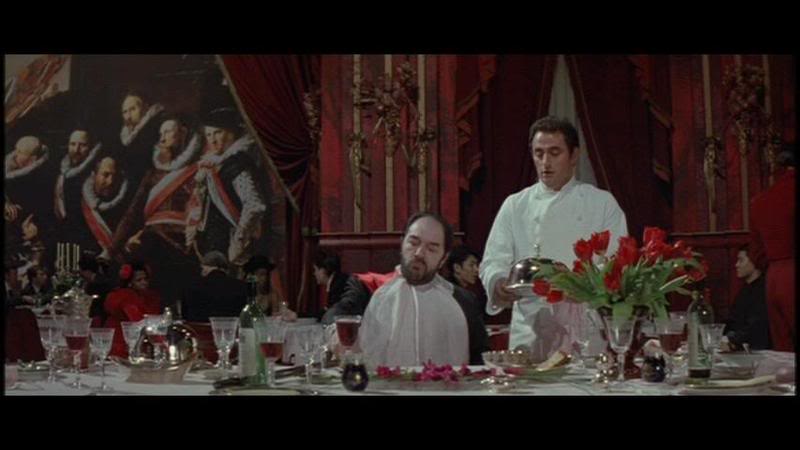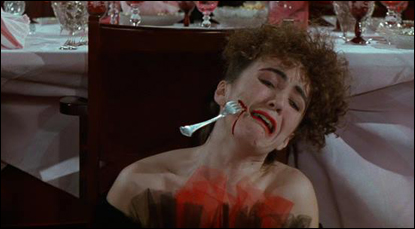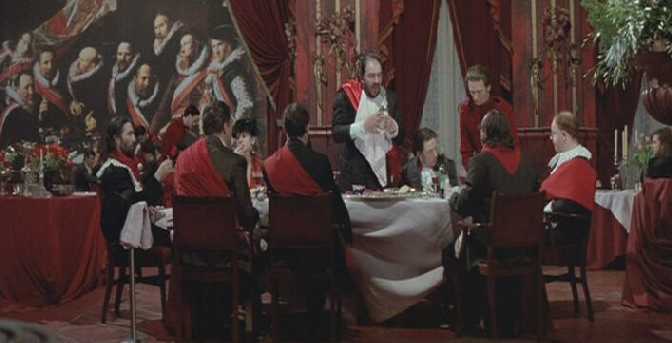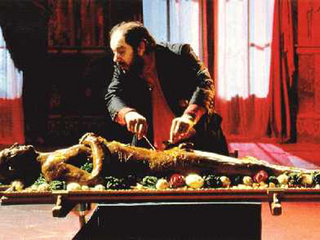From the Chicago Reader (April 13, 1990). — J.R.
THE COOK, THE THIEF, HIS WIFE & HER LOVER
* (Has redeeming facet)
Directed and written by Peter Greenaway
With Richard Bohringer, Michael Gambon, Helen Mirren, Alan Howard, and Tim Roth.
On the face of it, this movie seems to have a good many things going for it. Although he was born in 1942, Peter Greenaway is still probably the closest thing that the English art cinema currently has to an enfant terrible. A former painter and film editor who started making experimental films in the mid-60s, he achieved an international reputation with The Draughtsman’s Contract in 1982; he went on to become a star director and cult figure in Europe with several TV films and three more features that had considerable success in both England and France as well as on the international festival circuit — A Zed & Two Noughts (1986), The Belly of an Architect (1987), and Drowning by Numbers (1988) — although they have had only limited circulation in the U.S. A fair number of my film-buff friends swear by him, and he is commonly regarded as the most “advanced” art-house director currently working in England.
Greenaway’s latest feature makes sterling use of many of his longtime collaborators: Sacha Vierny, one of the best cinematographers alive (working here in ‘Scope), whose credits include Hiroshima, mon amour, Last Year at Marienbad, Muriel, Belle de jour, and Stavisky, as well as films by Raul Ruiz and Marguerite Duras; composer Michael Nyman, a sort of neoclassicist who has worked for everyone from the Royal Ballet to Steve Reich to Sting; and production designers Ben Van Os and Jan Roelfs, former interior designers who have worked in the Dutch film industry since 1983. His cast is unquestionably a distinguished one: Helen Mirren, for instance, has appeared in such films as Age of Consent, Savage Messiah, O Lucky Man!, Excalibur, and Pascali’s Island, while Richard Bohringer played a lead in Diva, and Michael Gambon played the starring role in the British miniseries The Singing Detective. The costumes were designed by French fashion designer Jean-Paul Gaultier, a Greenaway fan who agreed to work on the film for free.
None of these contributions, moreover, can be regarded as wasted: the film is beautifully lit, dressed, upholstered, mounted, acted, shot, scored, and color-coordinated. Why then do I find it so tedious, mechanical, and even conceptually ugly — downright irritating, in fact? Irritation, to be sure, can be an important tool to an avant-garde artist, but only if it serves as a lever, projecting the viewer into something else — a fresh perception or idea, a new definition of beauty or truth or, at the very least, content. But the irritation provoked by The Cook, the Thief, His Wife & Her Lover leads me nowhere. It’s as if Greenaway had all this artistry, including his own, at his disposal and created nothing but a dead piece of meat, for no reason in particular — unless it’s to express his contempt for his audience.
The movie certainly tries to be shocking and provocative — originally assigned an X by our rating system, it now has no rating at all — yet it is so lacking in soul that despite its audacity it seems like it could have been programmed on a computer. In one of his interviews, Greenaway has suggested that the film is supposed to be an attack on Thatcher England and conspicuous consumption, yet his vision is so doggedly and exclusively upper-class, here and elsewhere in his work, that this strikes me as rather feeble, or at the very least a prime example of the pot calling the kettle black. If Thatcher England is the movie’s target, some alternative to Thatcher England — if not explicit, at least implied — is necessary for this attack to have any meaning; but there is not even a hint of such an alternative anywhere in sight. To all appearances, Greenaway thrives on his hatred too much to imagine anything that might exist outside of it.
The film’s slender plot has a point of its own to make that is worth examining. (Readers who plan to see the film and don’t want to know the story’s outcome are advised to stop here and come back later.) A brutal, loutish gangster with social aspirations named Albert (Gambon) dines nightly at his own huge, expensive French restaurant called Le Hollandais, accompanied by his battered wife Georgina (Mirren) and various henchmen, as well as a shifting set of associates and cronies. Over the course of ten evenings (each heralded by a separate menu), Georgina makes eye contact with a quiet, solitary diner and bookworm named Michael (Alan Howard), makes love with him in the ladies’ room, and then, with the assistance of the chef (Bohringer), has sexual encounters with him in various pantries between courses.
Eventually, a girlfriend of one of the henchmen spills the beans to Albert, who stabs the informant with a fork and goes on a rampage, threatening to kill Michael and eat him. The chef manages to spirit the lovers, both nude, away in a refrigerated truck full of decaying meat and seafood. They go to Michael’s book depository, where they hide out; the chef sends a boy over with a meal for them, and Michael invites the boy to borrow any books he’d like. When the boy returns to Le Hollandais with the dirty dishes, Albert tortures him to find out the couple’s whereabouts, which he eventually discovers by seeing a bookplate in a borrowed book.
When the couple learn that the boy has been hospitalized, Georgina leaves to pay him a visit; then Albert and his stooges arrive at the depository and, after stuffing Michael’s nose and mouth with pages from his books, they kill him. Georgina finds Michael’s body, and after spending the night with his corpse, she visits the chef and persuades him to cook Michael for Albert to eat. Albert arrives at the restaurant, where Michael’s entire body is served to him on a platter. Georgina forces him at gunpoint to consume a single mouthful, then she shoots him dead, saying “Cannibal!” over his body.
Given all the excess that precedes this climax — including an opening sequence that shows Albert stripping a debtor in the restaurant parking lot, smearing him with dog shit, then pissing on him, and Albert’s virtually nonstop physical and verbal abuse of everyone in sight — the viewer may feel a little cheated that the villain’s comeuppance consists of only a single forkful of human flesh. It would have been more consistent with the film’s overall tactics if the totally repulsive Albert had been forced to clean his plate, even though it might have further strained the audience’s goodwill and patience. But a more drawn-out ending would have removed some of the pithy irony of Georgina’s closing epithet. It is an epithet that is clearly meant to rebound on the audience — with a good deal less irony.
It’s true that Greenaway hasn’t held us at gunpoint for the preceding 125 minutes, but he’s used enough heavy high-art artillery to cow us into submission nevertheless. Here are his major weapons:
Theater. The film is framed by the opening and closing of theatrical curtains, and Greenaway has been at pains to explain that his principal model for the story was the Jacobean revenge tragedy, with particular reference to John Ford’s ‘Tis Pity She’s a Whore.
Painting. The centerpiece of the dining room in Le Hollandais is an enormous painting by Frans Hals, Banquet of the Officers of the Saint George Civic Guard Company (1614), which functions as an ongoing cross-reference to Albert and his entourage.
Music. The cherubic boy who delivers the meal to Georgina and Michael in the book depository is a dishwasher who happens to be a soprano as well; Michael Nyman’s striking score features many choral passages, with the boy generally featured as live soloist whenever the camera glides past him in the kitchen.
History. Sean French, reviewing this film in the British magazine Sight and Sound, says, “The different rooms [in Le Hollandais] seem to represent different stages of history, an architectural mockery of human progress. The kitchen with its still lives and its fowl being dismembered is 18th century, the dining-room with its lush fabrics 19th century and the hi-tech bathroom late 20th.” Also, one of the pages stuffed into Michael’s mouth is the title page of a book called The French Revolution.
Color-coding. I quote now from the film’s press book, which is so explicit about the film’s intentions that it makes a critic’s interpretation superfluous: “The film features six rooms, each decorated and lit in a different color which symbolizes the kinds of actions which occur in that room: (1) the lavish restaurant dining room, where most of the verbal and physical abuse occurs, is blood-red, symbolizing danger; (2) the kitchen, where the lovers secretly meet, is jungle-green suggesting safety; (3) the parking lot, where the lovers flee, is a cold, ultramarine blue connoting the netherworld; (4) the lovers’ hideaway is gold to represent the golden age of learning and implying an Eden for the re-born innocents; (5) a children’s hospital ward which is the yellow of eggyolk and spring; and (6) the lavatories, where the lovers begin their affair, is the shadowless incandescent white of heaven.” Even Gaultier’s costumes sometimes change color to match the decor as the characters move from one room to another, followed by a laterally tracking camera.
Paradoxically yet characteristically, these heavy-duty art references are accompanied by dialogue that is relatively meandering and formless whenever it steps away from the film’s structural design. (Albert’s minor explosion of grief over his and Georgina’s childlessness, for instance, registers as an awkward attempt to cover up the absence of psychology elsewhere.) Greenaway’s obsessive reliance on structural systems — perspective (The Draughtsman’s Contract), the alphabet (A Zed & Two Noughts), numbers (Drowning by Numbers), and color-coding here — never functions as a means of exploration or discovery in the way that (for instance) the systems in Michael Snow’s experimental “structural films” like Wavelength, Back and Forth, and La Region Centrale do; they suggest the somewhat desperate tactics of a control freak who doesn’t really believe in or feel comfortable with narrative, but has to use it anyway to get his pictures financed and shown. They become, in effect, recipes for filming by numbers.
One can still enjoy Greenaway’s sarcasm and aesthetic eccentricity up to a point, if only because his intelligence, his art-history background, and his craft all provide a certain novelty in the art-film terrain that he has claimed since The Draughtsman’s Contract. That film had a pleasurable puzzlelike aspect and an intriguingly grim view of art patronage that fit in nicely with the handsome visuals and the cruel eroticism and wit, even if the laughter that greeted its showings often had an ugly and dehumanized sound to it. I got even more kicks out of A Zed & Two Noughts, my favorite Greenaway film, because of the sheer perversity, beauty, and complexity of its multifaceted conception. But I walked out of The Belly of an Architect, bored silly by the symmetrical center-framing and the turgidity of Greenaway’s preoccupation with midlife sexual crises, and even though I stayed to the end of Drowning by Numbers, I was just as bored by the mechanical jokes, conceits, and cruelties that made up the bulk of that film.
The Cook, the Thief, His Wife & Her Lover is in no way inferior to these last two films, though it’s highly likely that one’s attitude toward it will be determined by how many times one has already ridden through Greenaway’s narrow and maliciously nuanced structural exercises. If you would enjoy a sadistic filmmaker calling you a cannibal for sitting through two hours of attractively framed nastiness and abuse, you might find this picture to be right up your alley.
Greenaway’s frozen and aristocratic sense of irony — a major part of his equipment, and my major bone of contention — puts quotation marks around virtually everything that we see and hear; but without a context for this irony, we wind up responding to it as if it were a wallpaper pattern rather than an existential position, a dandified form of decoration that is too willful to be very funny, much less witty. If Greenaway were producing only wallpaper, I’d have no reason for complaint; by the same token, if making movies were a matter of academic achievement — showing how well he’s learned his lessons — I’d give him an A plus. Sergei Eisenstein once quipped of Lewis Milestone’s All Quiet on the Western Front, “It’s a good PhD thesis” — quite unfairly, in my opinion, because that film has both an emotional directness and an academic clunkiness that his remark overlooked, the precise opposite of what Greenaway has to offer. I couldn’t call The Cook, the Thief, His Wife & Her Lover a good PhD thesis because it has nothing serious to prove, but I wouldn’t hesitate to admit that it’s immaculately researched, conscientiously footnoted, and perfectly typed.





